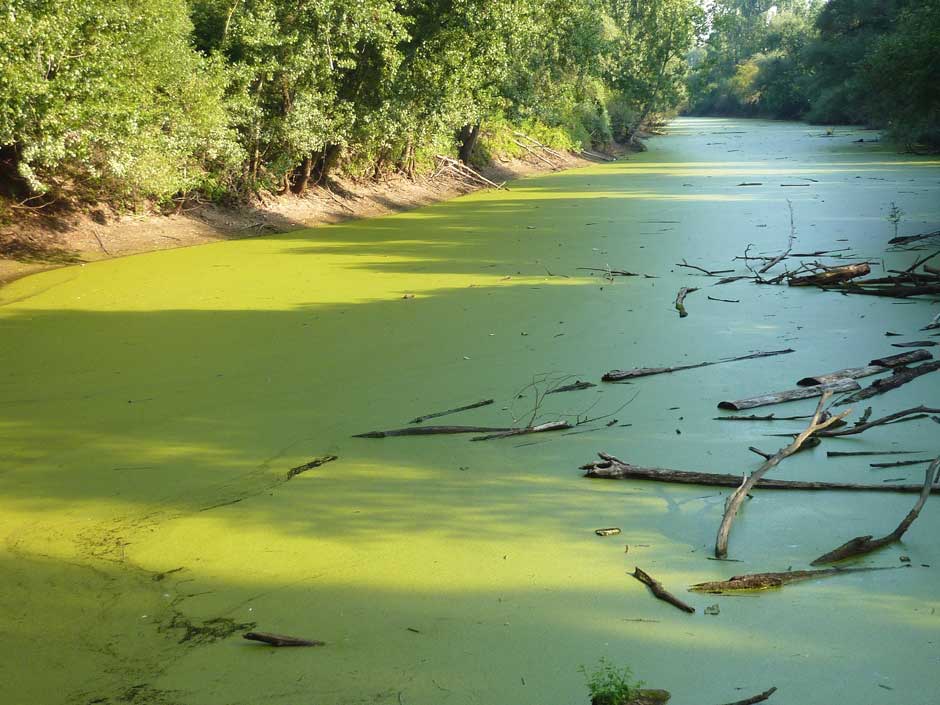Eutrophication Can Have a Harmful Effect on Dissolved Oxygen in Aquaculture

Eutrophication, believe it or not, has “good” right in its name. The word for an excess of nutrients that leads to too much plant and algae life (often causing problems) in a body of water comes from the ancient Greek word, eutrophos, meaning well-nourished. But, you know what they say about too much of a good thing. Today, eutrophication brings up images of lakes choked with algae and ponds overgrown with weeds. If you think of eutrophication, thoughts of algal blooms are likely right behind.
But scummy-looking water means more than a ruined view or a mucky smell. It might mean a crash in the all-important water quality parameter: dissolved oxygen. Without DO, a body of water—pond, lake, or part of the ocean—can die.
What does eutrophication have to do with dissolved oxygen?
Aquatic animal life (let’s say in a lake, though all these dynamics apply to aquaculture settings as well) depends on dissolved oxygen to breathe. Oxygen dissolves into water in a few ways. A spring or river of oxygen-rich water might feed a lake, adding its oxygen to the lake water and maintaining a healthy level. Oxygen also dissolves from the atmosphere. A turbulent surface speeds diffusion along, which is why a mountain stream is often full of oxygen and why aquaculturists employ aerators that churn the surface of fish ponds or enclosures. A third way oxygen levels increase in water is through aquatic plants supplementing oxygen during photosynthesis.
So why does a lot of plant growth, like what occurs in eutrophic waters, often drive down dissolved oxygen? For several reasons.
First, sunlight is the engine that drives photosynthesis. During a particularly intense algal bloom, the layer of algae at the water’s surface can block sunlight from penetrating to plants below. Without sunlight, plants stop photosynthesizing and begin respiring: using oxygen to maintain their normal functions. Fewer plants producing dissolved oxygen and more plants using it is a drain on the supply. This happens on a daily cycle, called the diel cycle, but sunlight-blocking plants means dissolved oxygen levels can’t recover during the day.
Second, an algal bloom will eventually die and something dead will ultimately decay. In decomposition, plant matter is broken down at the smallest level by bacteria. These bacteria rely on oxygen to sustain their vital functions. As they use up oxygen while decomposing dead plant matter, especially when there’s a lot of it like after an algal bloom, they can drive down oxygen levels even further.

Algal blooms can block sunlight and halt photosynthesis below the surface. Bolles Harbor, Lake Erie. (Credit: NOAA, public domain)
Without external mixing of the lake—like from wind or a change in temperature—deeper water can become hypoxic (low oxygen) or anoxic (no oxygen).
Hypoxic or anoxic water can kill or banish fish within its boundaries. Slower-moving creatures, like shellfish, can become trapped and killed. Areas like this are called dead zones.
Even the aerobic bacteria can give way to anaerobic bacteria, which carry on decomposing without the use of oxygen. Waste from anaerobic bacteria can include substances toxic to aquatic animals.
Eutrophication, dissolved oxygen and aquaculture
Dissolved oxygen is a key parameter in keeping fish healthy and growing. Eutrophication, in that it can cause dissolved oxygen to crash, can be a direct threat to the health of farmed fish and the success of an aquaculture operation. Above average plant and algae growth requires keeping a closer eye on dissolved oxygen levels.
Further, eutrophic water can be full of toxic algae. While the toxins they produce can be directly harmful to the water’s consumers, including humans, those toxins can also accumulate in organisms using those waters.
This is most likely to impact shellfish farmers. In some areas around North America, shellfish beds are closed to harvest because toxins reach levels dangerous to humans. Toxins can also bioaccumulate in predators farther up the food chain. Toxins that start in harmful algae can range from gastrointestinal discomfort to muscular problems to neurological damage.

Eutrophication, like this in an aquaculture pond in Benin, can depress dissolved oxygen levels and harm fish. (Credit: Adoscam/Wikimedia)
Cause of eutrophication today
Factors that can limit the growth of aquatic plants and algae include the amount of sunlight, available nutrients, water temperature and available carbon dioxide. If one of these increases significantly, it’s possible plant life will as well.
Nutrient levels in water bodies have been fluctuating in natural ways for years. Spring floods drive extra sediment down rivers, providing a concentrated shot of nutrients to the river’s mouth. A landslide into a lake might provide a huge shot of nutrients in the sediment it moves. Recently, unexpected algal blooms in Lake Superior have been connected to unusually heavy rain, which flushed sediment (and nutrients) into the water.
But, today hypoxic and anoxic waters along the coast are largely caused by human-caused nutrient runoff. Dead zones can be a problem for fish and shellfish farmers along the coast and the reduction of those dead zones could improve shellfish harvest. Some farmers may be feeling the direct effects.
Eutrophication can directly impact fish farming as well. In 1998, 90% of Hong Kong’s farmed fish were killed in a single algal bloom event.
Regardless of the source or effect, eutrophication can pose challenges for aquaculture, all the way down to the dissolved oxygen.



0 comments